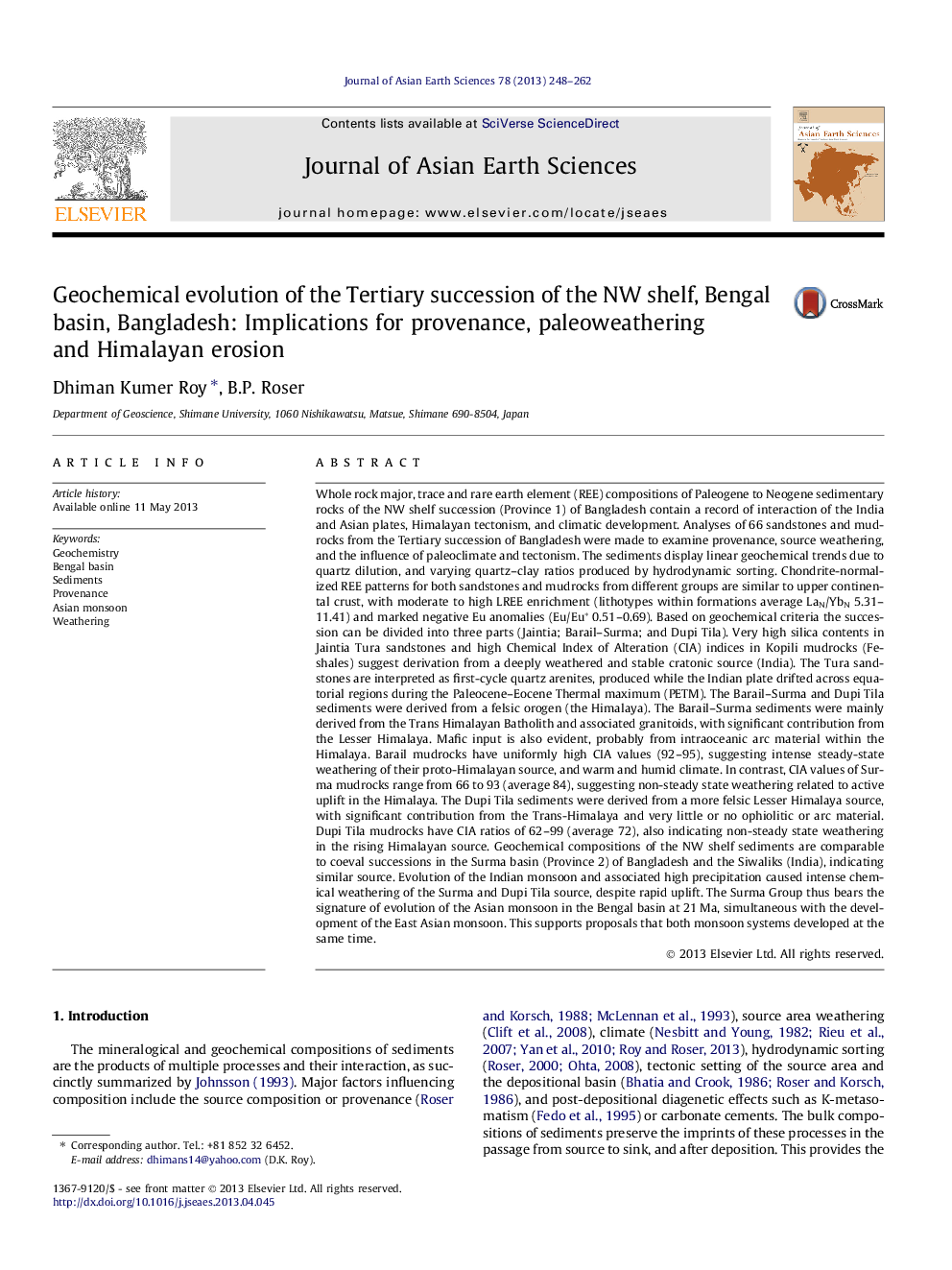| کد مقاله | کد نشریه | سال انتشار | مقاله انگلیسی | نسخه تمام متن |
|---|---|---|---|---|
| 4730846 | 1640389 | 2013 | 15 صفحه PDF | دانلود رایگان |

• New geochemical data for the Tertiary succession (NWS), Bengal basin, Bangladesh.
• Provenance change from cratonic to recycled orogen (Himalaya).
• Results show influence of Indian plate drift, PETM, Asian monsoon evolution.
• Sediments carry the signature of early Asian monsoon evolution in the Bengal basin.
Whole rock major, trace and rare earth element (REE) compositions of Paleogene to Neogene sedimentary rocks of the NW shelf succession (Province 1) of Bangladesh contain a record of interaction of the India and Asian plates, Himalayan tectonism, and climatic development. Analyses of 66 sandstones and mudrocks from the Tertiary succession of Bangladesh were made to examine provenance, source weathering, and the influence of paleoclimate and tectonism. The sediments display linear geochemical trends due to quartz dilution, and varying quartz–clay ratios produced by hydrodynamic sorting. Chondrite-normalized REE patterns for both sandstones and mudrocks from different groups are similar to upper continental crust, with moderate to high LREE enrichment (lithotypes within formations average LaN/YbN 5.31–11.41) and marked negative Eu anomalies (Eu/Eu* 0.51–0.69). Based on geochemical criteria the succession can be divided into three parts (Jaintia; Barail–Surma; and Dupi Tila). Very high silica contents in Jaintia Tura sandstones and high Chemical Index of Alteration (CIA) indices in Kopili mudrocks (Fe-shales) suggest derivation from a deeply weathered and stable cratonic source (India). The Tura sandstones are interpreted as first-cycle quartz arenites, produced while the Indian plate drifted across equatorial regions during the Paleocene–Eocene Thermal maximum (PETM). The Barail–Surma and Dupi Tila sediments were derived from a felsic orogen (the Himalaya). The Barail–Surma sediments were mainly derived from the Trans Himalayan Batholith and associated granitoids, with significant contribution from the Lesser Himalaya. Mafic input is also evident, probably from intraoceanic arc material within the Himalaya. Barail mudrocks have uniformly high CIA values (92–95), suggesting intense steady-state weathering of their proto-Himalayan source, and warm and humid climate. In contrast, CIA values of Surma mudrocks range from 66 to 93 (average 84), suggesting non-steady state weathering related to active uplift in the Himalaya. The Dupi Tila sediments were derived from a more felsic Lesser Himalaya source, with significant contribution from the Trans-Himalaya and very little or no ophiolitic or arc material. Dupi Tila mudrocks have CIA ratios of 62–99 (average 72), also indicating non-steady state weathering in the rising Himalayan source. Geochemical compositions of the NW shelf sediments are comparable to coeval successions in the Surma basin (Province 2) of Bangladesh and the Siwaliks (India), indicating similar source. Evolution of the Indian monsoon and associated high precipitation caused intense chemical weathering of the Surma and Dupi Tila source, despite rapid uplift. The Surma Group thus bears the signature of evolution of the Asian monsoon in the Bengal basin at 21 Ma, simultaneous with the development of the East Asian monsoon. This supports proposals that both monsoon systems developed at the same time.
Journal: Journal of Asian Earth Sciences - Volume 78, 15 December 2013, Pages 248–262